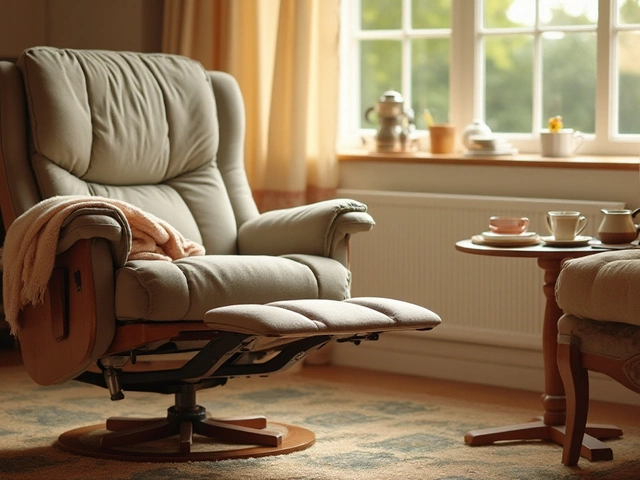Let's be real, arm chairs might look cozy, but they're not always the best fit for the office. Why? Well, for starters, they often compromise comfort, especially during those marathon work sessions. The plush padding might fool you into thinking they're a dream, but without proper support, that dream can quickly turn into a sore back.
Another biggie is the lack of ergonomic design. Arm chairs typically don't provide the right support for your posture, which can be a nightmare for your spine and overall well-being. When you're locked into a certain angle or position, it's easy to find yourself slouching or craning your neck awkwardly.
- Comfort Compromised
- Ergonomics Overlooked
- Limited Adjustability
- Space Consumption
- Maintenance Challenges
- Cost Considerations
Comfort Compromised
Alright, so let's talk about how comfort sometimes takes a backseat when it comes to arm chairs in the office. At first glance, they seem like the perfect, cushy haven for long workdays. But seep a little deeper, and you might not be so comfy after all.
Why are these chairs falling short in terms of comfort? Well, one of the main reasons is the lack of ergonomic features. Most office chairs today are designed to support your natural posture, but arm chairs can often miss the mark. Without adjustable height and tilt, you're stuck with one size fits all, which - newsflash - doesn’t really fit all!
Static Armrests and Backrests
Another bummer is the static nature of the arm and backrests. While they may offer a semblance of support, the absence of flexibility means you're not getting the dynamic backing your hardworking body needs throughout the day. This rigidity can lead to discomfort and even pain, especially in the neck and shoulders.
The Cushion Conundrum
Plus, there's the cushion conundrum. Start the day, and it feels like sitting on a cloud. Fast forward a few hours, however, and it might feel more like a deflated balloon. Over time, cheap materials can sag and lose their form, leaving you sitting in an awkward, uncomfortable position.
In our quest for coziness, keep in mind: proper support often trumps that initial soft appeal. So when picking the ideal office chair, consider the long hours you’ll spend in it and how your body reacts. After all, an inviting seat isn't much good if it leaves you counting down to quitting time.
Ergonomics Overlooked
When it comes to setting up a workspace, ergonomics often take center stage. The goal is to prevent discomfort and injuries, especially in jobs that demand long hours at a desk. So, why are arm chairs sometimes seen as the bad guys in this scenario? It boils down to a lack of support in key areas.
Poor Lumbar Support
Most office enthusiasts will tell you that lumbar support is non-negotiable. Yet, typical arm chairs often lack the structured back support needed to maintain that natural curve in your lower back. This oversight can lead to slouching and long-term spinal issues.
Lack of Adjustability
Being able to tweak your chair's height, backrest, and armrests is huge for keeping ergonomic setups personalized and effective. However, arm chairs usually come with limited adjustment options, making it tough to find that sweet spot for productivity and comfort.
Static Seating
Compared to fully ergonomic chairs, arm chairs might keep you locked into one position. Office ergonomics emphasizes movement and flexibility—being able to shift, stretch, and fidget helps keep your body alert and comfortable. Chairs without these options tend to hinder this flexibility.
Here's a quick comparison to see how arm chairs stack up against ergonomic chairs:
| Feature | Arm Chairs | Ergonomic Chairs |
|---|---|---|
| Adjustable Backrest | No | Yes |
| Rocker Mechanism | No | Yes |
| Lumbar Support | Minimal | Comprehensive |
So, next time you're in the market for office chairs, think about what matters most. Ergonomics isn't just a buzzword—it's your ticket to a healthier, happier work experience.
Limited Adjustability
Here's the deal with most arm chairs: they're not built for flexibility. In many office environments, having a chair that adapts to your body's needs is crucial. Unfortunately, arm chairs usually fall short in this department. You're basically stuck in one position, which isn't great if you're trying to stay comfortable throughout the day.
Why Adjustability Matters
Being able to tweak your office chair's settings means you can avoid unneeded strain. Adjustable chairs can accommodate different heights, depths, and angles, allowing you to maintain a healthy posture. Without these features, you might as well be sitting on a wooden bench. And we all know how that ends.
According to Dr. Linda Miller, an ergonomic specialist, "A chair with minimal adjustability can lead to static postures, which over time, can cause discomfort and even musculoskeletal issues."
"Work environments where employees are stuck in the same position throughout the day see more complaints about back pain and fatigue because chairs aren't adaptable enough to align with the user's natural posture." - Dr. Linda Miller, Ergonomic Specialist
Common Adjustability Features Lacking in Arm Chairs
- Seat Height Adjustment: Not being able to raise or lower your seat can lead to awkward postures, especially if your desk height is fixed.
- Armrest Adjustability: Fixed armrests can prevent you from getting close enough to your desk, leading to slouching.
- Lumbar Support: Without the ability to adjust back support, your lower back might not get the support it needs, leading to discomfort and potential long-term issues.
Considering Office Needs
If you're switching between tasks that require different types of seating, it's even more important. The limited adjustability of an arm chair means it's simply not as versatile. So, if you're wondering why your neck or back has been bothering you, it might be time to reconsider your seating solution.

Space Consumption
Alright, let's talk about space, because let's face it, most offices aren't exactly palatial. Arm chairs are notorious for hogging space, thanks to their bulky build and wide armrests. In a cozy living room, this might be fine, but in an office setting, every square foot counts.
According to a study conducted by Office Space Solutions, the average office arm chair occupies around 25% more space than a typical ergonomic office chair. This can be a big deal, especially in open-plan offices where maximizing the number of workstations is crucial.
"Choosing furniture with a smaller footprint can increase the number of workstations by 15-20%, which can be a game-changer for growing companies," says Jane Collier, a workplace design expert.
Efficiency Matters
The truth is, the more space your office chairs occupy, the less room you have for other essentials like storage units or additional equipment. This isn't just about cramming in as many seats as possible—it's also about ensuring employees have room to breathe.
- Larger chairs might make maneuvering around the office a hassle, especially in high-traffic areas.
- If meeting rooms are tight on space, you might have to sacrifice seating capacity for more clunky chairs, which isn't ideal for gatherings.
Making Smarter Choices
So, what can you do? Prioritize furniture that serves its purpose without being a space hog. Look for alternatives with sleeker designs and reduced dimensions. It's not just about saving space; it's about creating an environment where everyone feels comfortable and efficient.
Maintenance Challenges
If you've ever tried maintaining arm chairs, you know it's not always a walk in the park. These chairs can be quite a handful when it comes to upkeep, especially in an office setting.
Office chairs with arms tend to collect dust and dirt over time. Those plush surfaces we mentioned earlier? They can become a magnet for stains, especially with the occasional coffee spill. Cleaning fabric arm chairs, in particular, can be a chore. If yours has removable covers, you're in luck, but many don't, making spot cleaning your only option.
Durability Woes
Typically, arm chairs also face wear and tear faster than their simpler counterparts. The arms are usually the first casualties of relentless use. They might become wobbly or the upholstery might start to wear out. If those armrests are attached with screws, frequent tightening might be in your future.
Repair and Replacement
When it comes to repairs, finding the right parts might be like searching for a needle in a haystack. Arm chairs are not as standardized as other chairs, so if an arm breaks or a wheel goes missing, replacement parts may not be readily available.
To make matters worse, if a repair becomes necessary, it might end up costing nearly as much as replacing the whole chair. This is something to consider when budgeting for office seating solutions.
Cost Considerations
When it comes to outfitting an office, staying within budget is a big deal. Arm chairs might seem like a soft, comfy choice, but they can also hit the wallet harder than you'd expect. Let's break down why that's the case.
Firstly, the initial price tag for arm chairs in the office can be deceptively high. These chairs often come with luxury materials and stylish designs that drive up costs. If you're decking out a whole office, those numbers really add up. Plus, the fashionable look doesn’t always translate to practical use, especially in a business setting.
Maintenance Costs
It's not just about the upfront payment. Maintaining these office chairs can also get pricey. Fancy upholstery or unique construction might require special cleaning regimes, and if parts break, getting replacements could burn a hole in your pocket. Imagine spilling coffee on a leather armchair—the cleanup can be tricky!
Space vs. Cost Efficiency
Another overlooked aspect is how much space these chairs take up. Bets are, if you're working with limited office space, fewer chairs fit in, which means either crowding the room or buying fewer seats to adhere to cost. In essence, every square foot costs money, so oversized chairs might not be the best bang for your buck if you're considering space utility along with cost.
Long-Term Investment
Even though arm chairs can be tempting due to their looks, it's smart to think about their longevity and comfort value over time. A chair that feels nice initially could end up being unsuitable for long hours of work, leading to discomfort and productivity dips—indirect costs nobody needs.



